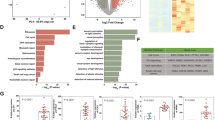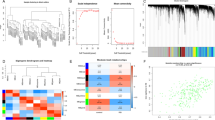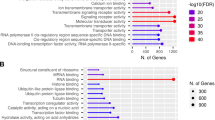Abstract
Retinoblastoma (RB) is a pediatric cancer of the eye that occurs in 1/15000 live births worldwide. Albeit RB is initiated by the inactivation of RB1 gene, the disease progression relies largely on transcriptional alterations. Therefore, evaluating gene expression is vital to unveil the therapeutic targets in RB management. In this study, we employed an RT2 Profiler™ PCR array for a focused analysis of 84 cancer-specific genes in RB. An interaction network was built with gene expression data to identify the dysregulated pathways in RB. The key transcript alterations identified in 13 tumors by RT2 Profiler™ PCR array was further validated in 15 tumors by independent RT-qPCR. Out of 84 cancer-specific genes, 68 were dysregulated in RB tumors. Among the 68 genes, 23 were chosen for further analysis based on statistical significance and abundance across multiple tumors. Pathway analysis of altered genes showed the frequent perturbations of cell cycle, angiogenesis and apoptotic pathways in RB. Notably, upregulation of MCM2, MKI67, PGF, WEE1, CDC20 and downregulation of COX5A were found in all the tumors. Western blot confirmed the dysregulation of identified targets at protein levels as well. These alterations were more prominent in invasive RB, correlating with the disease pathogenesis. Our molecular analysis thus identified the potential therapeutic targets for improving retinoblastoma treatment. We also suggest that PCR array can be used as a tool for rapid and cost-effective gene expression analysis.





Similar content being viewed by others
Data availability
The datasets generated during and/or analyzed during the current study are available from the corresponding author on request.
References
Balaji S, Santhi R, Kim U, Muthukkaruppan V, Priya CG, Vanniarajan A. Cancer stem cells with overexpression of neuronal markers enhance chemoresistance and invasion in retinoblastoma. Curr Cancer Drug Targets. 2020;20(9):710–9. https://doi.org/10.2174/1568009620666200504112711.
Thirumalairaj K, Abraham A, Devarajan B, Gaikwad N, Kim U, Muthukkaruppan V, et al. A stepwise strategy for rapid and cost-effective RB1 screening in Indian retinoblastoma patients. J Hum Genet. 2015;60(9):547–52. https://doi.org/10.1038/jhg.2015.62.
Mendonca V, Evangelista AC, B PM, MA MM, Faria P, Lucena E, et al. Molecular alterations in retinoblastoma beyond RB1. Exp Eye Res. 2021;211:108753.https://doi.org/10.1016/j.exer.2021.108753
Theriault BL, Dimaras H, Gallie BL, Corson TW. The genomic landscape of retinoblastoma: a review. Clin Exp Ophthalmol. 2014;42(1):33–52. https://doi.org/10.1111/ceo.12132.
Kooi IE, Mol BM, Moll AC, van der Valk P, de Jong MC, de Graaf P, et al. Loss of photoreceptorness and gain of genomic alterations in retinoblastoma reveal tumor progression. EBioMedicine. 2015;2(7):660–70. https://doi.org/10.1016/j.ebiom.2015.06.022.
Chakraborty S, Khare S, Dorairaj SK, Prabhakaran VC, Prakash DR, Kumar A. Identification of genes associated with tumorigenesis of retinoblastoma by microarray analysis. Genomics. 2007;90(3):344–53. https://doi.org/10.1016/j.ygeno.2007.05.002.
Ganguly A, Shields CL. Differential gene expression profile of retinoblastoma compared to normal retina. Mol Vis. 2010;16:1292–303, https://pubmed.ncbi.nlm.nih.gov/20664703
McEvoy J, Flores-Otero J, Zhang J, Nemeth K, Brennan R, Bradley C, et al. Coexpression of normally incompatible developmental pathways in retinoblastoma genesis. Cancer Cell. 2011;20(2):260–75. https://doi.org/10.1016/j.ccr.2011.07.005.
Kim U, Rathi G, Chowdhary G, Srinavasan KG, Shanthi R, Krishna RSP. Accuracy of preoperative imaging in predicting optic nerve invasion in retinoblastoma: a retrospective study. Indian J Ophthalmol. 2019;67(12):2019–22. https://doi.org/10.4103/ijo.IJO_1611_18.
Shields CL, Shields JA, Baez K, Cater JR, De Potter P. Optic nerve invasion of retinoblastoma. Metastatic potential and clinical risk factors. Cancer. 1994;73(3):692–8.https://doi.org/10.1002/1097-0142(19940201)73:3<692::aid-cncr2820730331>3.0.co;2-8
Shields CL, Shields JA, Baez KA, Cater J, Potter PVD. Choroidal invasion of retinoblastoma: metastatic potential and clinical risk factors. Br J Ophthalmol. 1993;77(9):544. https://doi.org/10.1136/bjo.77.9.544.
Bartha Á, Győrffy B. TNMplot.com: a web tool for the comparison of gene expression in normal, tumor and metastatic tissues. Int J Mol Sci. 2021;22(5).https://doi.org/10.3390/ijms22052622
Balaji S, Vanniarajan A. Implication of pseudo reference genes in normalization of data from reverse transcription-quantitative pcR. Gene. 2020. https://doi.org/10.1016/j.gene.2020.144948;10.1016/j.gene.2020.144948:144948.10.1016/j.gene.2020.144948.
Laurell H, Iacovoni JS, Abot A, Svec D, Maoret JJ, Arnal JF, et al. Correction of RT-qPCR data for genomic DNA-derived signals with ValidPrime. Nucleic Acids Res. 2012;40(7):e51. https://doi.org/10.1093/nar/gkr1259.
Francis JH, Richards AL, Mandelker DL, Berger MF, Walsh MF, Dunkel IJ, et al. Molecular changes in retinoblastoma beyond rb1: findings from next-generation sequencing. Cancers (Basel). 2021;13(1).https://doi.org/10.3390/cancers13010149
Kandalam M, Mitra M, Subramanian K, Biswas J. Molecular pathology of retinoblastoma. Middle East Afr J Ophthalmol. 2010;17(3):217–23. https://doi.org/10.4103/0974-9233.65498.
Sun Y, Cheng Z, Liu S. MCM2 in human cancer: functions, mechanisms, and clinical significance. Mol Med. 2022;28(1):128. https://doi.org/10.1186/s10020-022-00555-9.
Yang J, Li Y, Han Y, Feng Y, Zhou M, Zong C, et al. Single-cell transcriptome profiling reveals intratumoural heterogeneity and malignant progression in retinoblastoma. Cell Death Dis. 2021;12(12):1100. https://doi.org/10.1038/s41419-021-04390-4.
Wu C, Yang J, **ao W, Jiang Z, Chen S, Guo D, et al. Single-cell characterization of malignant phenotypes and microenvironment alteration in retinoblastoma. Cell Death Dis. 2022;13(5):438. https://doi.org/10.1038/s41419-022-04904-8.
**an F, Zhao C, Huang C, Bie J, Xu G. The potential role of CDC20 in tumorigenesis, cancer progression and therapy: a narrative review. Medicine (Baltimore). 2023;102(36):e35038. https://doi.org/10.1097/MD.0000000000035038.
Zhang Y, Zhou L, Wang S, Wang M, Wu S. Exploration of retinoblastoma pathogenesis with bioinformatics. Transl Cancer Res. 2021;10(7):3527–37.https://doi.org/10.21037/tcr-21-1034
Esposito F, Giuffrida R, Raciti G, Puglisi C, Forte S. Wee1 kinase: a potential target to overcome tumor resistance to therapy. Int J Mol Sci. 2021;22(19).https://doi.org/10.3390/ijms221910689
Li A, Yang J, Zhang T, Li L, Li M. Long Noncoding RNA TRPM2-AS Promotes the Growth, Migration, and Invasion of Retinoblastoma via miR-497/WEE1 Axis. Front Pharmacol. 2021;12.https://doi.org/10.3389/fphar.2021.592822
Kim N, Ko Y, Shin Y, Park J, Lee AJ, Kim KW, et al. Comprehensive analysis for anti-cancer target-indication prioritization of placental growth factor inhibitor (PGF) by use of omics and patient survival data. Biology. 2023;12(7):970, https://www.mdpi.com/2079-7737/12/7/970
Aoki S, Inoue K, Klein S, Halvorsen S, Chen J, Matsui A, et al. Placental growth factor promotes tumour desmoplasia and treatment resistance in intrahepatic cholangiocarcinoma. Gut. 2022;71(1):185–93. https://doi.org/10.1136/gutjnl-2020-322493.
Liu J, Zhan X, Li M, Li G, Zhang P, **ao Z, et al. Mitochondrial proteomics of nasopharyngeal carcinoma metastasis. BMC Med Genomics. 2012;5:62. https://doi.org/10.1186/1755-8794-5-62.
Nath S, Chowdhury A, Dey S, Roychoudhury A, Ganguly A, Bhattacharyya D, et al. Deregulation of Rb-E2F1 axis causes chromosomal instability by engaging the transactivation function of Cdc20-anaphase-promoting complex/cyclosome. Mol Cell Biol. 2015;35(2):356–69. https://doi.org/10.1128/MCB.00868-14.
Poppy Roworth A, Ghari F, La Thangue NB. To live or let die - complexity within the E2F1 pathway. Mol Cell Oncol. 2015;2(1):e970480. https://doi.org/10.4161/23723548.2014.970480.
Hamidi M, Eriz A, Mitxelena J, Fernandez-Ares L, Aurrekoetxea I, Aspichueta P, et al. targeting e2f sensitizes prostate cancer cells to drug-induced replication stress by promoting unscheduled CDK1 activity. Cancers (Basel). 2022;14(19).https://doi.org/10.3390/cancers14194952
Uxa S, Castillo-Binder P, Kohler R, Stangner K, Müller GA, Engeland K. Ki-67 gene expression. Cell Death Differ. 2021;28(12):3357–70. https://doi.org/10.1038/s41418-021-00823-x.
Blanchet E, Annicotte JS, Lagarrigue S, Aguilar V, Clape C, Chavey C, et al. E2F transcription factor-1 regulates oxidative metabolism. Nat Cell Biol. 2011;13(9):1146–52. https://doi.org/10.1038/ncb2309.
Huang HC, Shi J, Orth JD, Mitchison TJ. Evidence that mitotic exit is a better cancer therapeutic target than spindle assembly. Cancer Cell. 2009;16(4):347–58. https://doi.org/10.1016/j.ccr.2009.08.020.
Mrouj K, Andres-Sanchez N, Dubra G, Singh P, Sobecki M, Chahar D, et al. Ki-67 regulates global gene expression and promotes sequential stages of carcinogenesis. Proc Natl Acad Sci U S A. 2021;118(10).https://doi.org/10.1073/pnas.2026507118
Murrow LM, Garimella SV, Jones TL, Caplen NJ, Lipkowitz S. Identification of WEE1 as a potential molecular target in cancer cells by RNAi screening of the human tyrosine kinome. Breast Cancer Res Treat. 2010;122(2):347–57. https://doi.org/10.1007/s10549-009-0571-2.
** T, Xu W, Chen R, Shen L, Gao J, Xu L, et al. Discovery of potential WEE1 inhibitors via hybrid virtual screening. Front Pharmacol. 2023;14:1298245. https://doi.org/10.3389/fphar.2023.1298245.
Yang C, Li Z, Li Q, **a Y, Chan C-C, Yuan X, et al. Preclinical evaluation of SC0191, a small molecule inhibitor of Wee1 kinase. J Clin Oncol. 2020;38(15_suppl):e15637-e.https://doi.org/10.1200/JCO.2020.38.15_suppl.e15637
Bruno S, Ghelli Luserna di Rora A, Napolitano R, Soverini S, Martinelli G, Simonetti G. CDC20 in and out of mitosis: a prognostic factor and therapeutic target in hematological malignancies. J Exp Clin Cancer Res. 2022;41(1):159.https://doi.org/10.1186/s13046-022-02363-9
Lub S, Maes A, Maes K, De Veirman K, De Bruyne E, Menu E, et al. Inhibiting the anaphase promoting complex/cyclosome induces a metaphase arrest and cell death in multiple myeloma cells. Oncotarget. 2016;7(4):4062–76.https://doi.org/10.18632/oncotarget.6768
Kim ME, Xu L, Prabakar RK, Shen L, Peng CC, Kuhn P, et al. Aqueous humor as a liquid biopsy for retinoblastoma: clear corneal paracentesis and genomic analysis. J Vis Exp. 2021. https://doi.org/10.3791/62939;10.3791/62939(175).10.3791/62939.
Levy J, Frenkel S, Baras M, Neufeld M, Pe’er J. Calcification in retinoblastoma: histopathologic findings and statistical analysis of 302 cases. Br J Ophthalmol. 2011;95(8):1145–50. https://doi.org/10.1136/bjo.2010.193961.
Wang L, Zhang J, Wan L, Zhou X, Wang Z, Wei W. Targeting Cdc20 as a novel cancer therapeutic strategy. Pharmacol Ther. 2015;151:141–51. https://doi.org/10.1016/j.pharmthera.2015.04.002.
Cheung CHY, Hsu CL, Chen KP, Chong ST, Wu CH, Huang HC, et al. MCM2-regulated functional networks in lung cancer by multi-dimensional proteomic approach. Sci Rep. 2017;7(1):13302. https://doi.org/10.1038/s41598-017-13440-x.
Sun X, Kaufman PD. Ki-67: more than a proliferation marker. Chromosoma. 2018;127(2):175–86. https://doi.org/10.1007/s00412-018-0659-8.
Do K, Doroshow JH, Kummar S. Wee1 kinase as a target for cancer therapy. Cell Cycle. 2013;12(19):3159–64. https://doi.org/10.4161/cc.26062.
Tang A, Gao K, Chu L, Zhang R, Yang J, Zheng J. Aurora kinases: novel therapy targets in cancers. Oncotarget. 2017;8(14):23937–54.https://doi.org/10.18632/oncotarget.14893
Hsu J, Sage J. Novel functions for the transcription factor E2F4 in development and disease. Cell Cycle. 2016;15(23):3183–90.https://doi.org/10.1080/15384101.2016.1234551
Wang S, Akhtar J, Wang Z. Anti-STMN1 therapy improves sensitivity to antimicrotubule drugs in esophageal squamous cell carcinoma. Tumour Biol. 2015;36(10):7797–806. https://doi.org/10.1007/s13277-015-3520-1.
Kim KJ, Cho CS, Kim WU. Role of placenta growth factor in cancer and inflammation. Exp Mol Med. 2012;44(1):10–9. https://doi.org/10.3858/emm.2012.44.1.023.
Tamura K, Hashimoto K, Suzuki K, Yoshie M, Kutsukake M, Sakurai T. Insulin-like growth factor binding protein-7 (IGFBP7) blocks vascular endothelial cell growth factor (VEGF)-induced angiogenesis in human vascular endothelial cells. Eur J Pharmacol. 2009;610(1–3):61–7. https://doi.org/10.1016/j.ejphar.2009.01.045.
Takayama Y, Hattori N, Hamada H, Masuda T, Omori K, Akita S, et al. Inhibition of PAI-1 limits tumor angiogenesis regardless of angiogenic stimuli in malignant pleural mesothelioma. Cancer Res. 2016;76(11):3285–94. https://doi.org/10.1158/0008-5472.CAN-15-1796.
Hu B, Cheng SY. Angiopoietin-2: development of inhibitors for cancer therapy. Curr Oncol Rep. 2009;11(2):111–6. https://doi.org/10.1007/s11912-009-0017-3.
Sharifi M, Moridnia A. Apoptosis-inducing and antiproliferative effect by inhibition of miR-182-5p through the regulation of CASP9 expression in human breast cancer. Cancer Gene Ther. 2017;24(2):75–82. https://doi.org/10.1038/cgt.2016.79.
Lu J, Tan M, Cai Q. The Warburg effect in tumor progression: mitochondrial oxidative metabolism as an anti-metastasis mechanism. Cancer letters. 2015;356(2 Pt A):156–64.https://doi.org/10.1016/j.canlet.2014.04.001
Frederick M, Skinner HD, Kazi SA, Sikora AG, Sandulache VC. High expression of oxidative phosphorylation genes predicts improved survival in squamous cell carcinomas of the head and neck and lung. Sci Rep. 2020;10(1):6380. https://doi.org/10.1038/s41598-020-63448-z.
Aoude LG, Pritchard AL, Robles-Espinoza CD, Wadt K, Harland M, Choi J, et al. Nonsense mutations in the shelterin complex genes ACD and TERF2IP in familial melanoma. J Natl Cancer Inst. 2015;107(2).https://doi.org/10.1093/jnci/dju408
Kohno T, Takahashi M, Manda R, Yokota J. Inactivation of the PTEN/MMAC1/TEP1 gene in human lung cancers. Genes Chromosom Cancer. 1998;22(2):152–6. https://doi.org/10.1002/(sici)1098-2264(199806)22:2%3c152::aid-gcc10%3e3.0.co;2-s.
Acknowledgements
We acknowledge all the RB patients and parents for their participation in this study. We duly acknowledge Senior Research fellowship for Rathinavel Sethu Nagarajan (2021-13793/SCR-BMS) from Indian Council for Medical Research and Junior and Senior Research Scholarship for Karuvel Kannan Saraswathi from Lady Tata Memorial Trust.
Funding
This work was supported by Science and Engineering Research Board, Department of Science and Technology, Government of India (EMR/2017/000285).
Author information
Authors and Affiliations
Contributions
AV, UK and VM conceptualized the study. SB, AR, KKS, RSN and RS performed data curation and analysis. SB, AR, KKS, RSN and AV have written the manuscript. All the authors reviewed and accepted the final version of the manuscript.
Corresponding author
Ethics declarations
Conflict of interest
We declared that none of the authors has financial and personal competing interests.
Ethical approval
This study was performed in line with the principles of the Declaration of Helsinki. Approval was granted by the Ethics Committee of the Institutional Review Board of Aravind Medical Research Foundation (IRB2017009BAS).
Consent to participate
All tumor samples were collected with the informed consent from patient/family.
Additional information
Publisher's Note
Springer Nature remains neutral with regard to jurisdictional claims in published maps and institutional affiliations.
Supplementary Information
Below is the link to the electronic supplementary material.
Rights and permissions
Springer Nature or its licensor (e.g. a society or other partner) holds exclusive rights to this article under a publishing agreement with the author(s) or other rightsholder(s); author self-archiving of the accepted manuscript version of this article is solely governed by the terms of such publishing agreement and applicable law.
About this article
Cite this article
Balaji, S., Rao, A., Saraswathi, K.K. et al. Focused cancer pathway analysis revealed unique therapeutic targets in retinoblastoma. Med Oncol 41, 168 (2024). https://doi.org/10.1007/s12032-024-02391-9
Received:
Accepted:
Published:
DOI: https://doi.org/10.1007/s12032-024-02391-9




